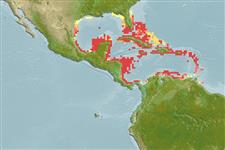Gastropoda |
Cycloneritida |
Neritidae
Environment: milieu / climate zone / गहराई सीमा / distribution range
पारिस्थितिकी
प्रवाल-भित्ति संयुक्त; गहराई सीमा 0 - 20 m (संदर्भ 109264). Tropical; 32°N - 9°N, 92°E - 60°E (संदर्भ 83435)
Western Atlantic.
Length at first maturity / आकार / Weight / Age
परिपक्व अवधि: Lm ? range ? - ? cm Max length : 4.7 cm NG पुल्लिंग / अलिंग; (संदर्भ 83435); common length : 4.0 cm TL पुल्लिंग / अलिंग; (संदर्भ 355)
Shell solid, globular, sculpture of strong spiral cords fading out on last whorl. Aperture large, inner lip with 1 to 3 white tooth-like projections, with blood red blotch, outer lip finely crenulated. Colour: shell colour yellowish mottled with red and black.
Combination depth range: min from literature (Ref. 109264), max from estimate. Inhabits rocky coasts in intertidal zones, usually in high-energy environments. Known to exhibit 'homing' behavior, moving in search of shelter during the day and foraging at night (Ref. 355).
Life cycle and mating behavior
परिपक्व अवधि | पुनरुत्पत्ति | मछलीऔ का अंडे देना | Eggs | Fecundity | Larvae
Members of the order Neritopsina are mostly gonochoric and broadcast spawners. Life cycle: Embryos develop into planktonic trocophore larvae and later into juvenile veligers before becoming fully grown adults.
Leal, J.H. 2003 Gastropods. p. 99-147. In Carpenter, K.E. (ed.). The living marine resources of the Western Central Atlantic. Volume 1: Introduction, molluscs, crustaceans, hagfishes, sharks, batoid fishes, and chimaeras. FAO Species Identification Guide for Fishery Purposes and American Society of Ichthyologists and Herpetologists Special Publication No. 5. 1600p. (संदर्भ 355)
IUCN Red List Status
(संदर्भ 130435: Version 2025-1)
CITES status (संदर्भ 108899)
Not Evaluated
CMS (संदर्भ 116361)
Not Evaluated
Threat to humans
Human uses
मात्स्यिकी: व्यापारिक
| FishSource |
साधन
अधिक जानकारी
Trophic EcologyFood items (preys)
संघटक आहार
आहार खपत
परभक्षी
Population dynamicsबाढ़Max. ages / sizesLength-weight rel.Length-length rel.Length-frequenciesMass conversionबहुतायत Life cycleपुनरुत्पत्तिपरिपक्व अवधिFecundityमछलीऔ का अंडे देनाEggsEgg developmentLarvae PhysiologyOxygen consumption
Human RelatedStamps, coins, misc.
इंटरनेट स्रोत
Estimates based on models
Preferred temperature
(Ref.
115969): 26.1 - 28.2, mean 27.4 (based on 526 cells).
Fishing Vulnerability
Low vulnerability (10 of 100).
Price category
Unknown.
